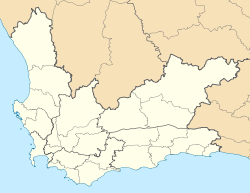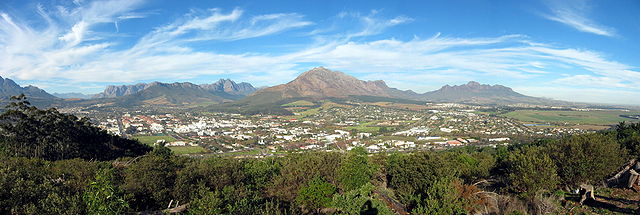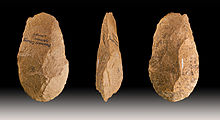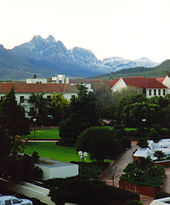- Stellenbosch
-
This article is about the town. For the university, see Stellenbosch University. For the municipality, see Stellenbosch Local Municipality.
Stellenbosch — Town — Nickname(s): Eikestad, Matiestad, Matieland Coordinates: 33°55′12″S 18°51′36″E / 33.92°S 18.86°ECoordinates: 33°55′12″S 18°51′36″E / 33.92°S 18.86°E Country  South Africa
South AfricaProvince Western Cape District Cape Winelands Local municipality Stellenbosch Founder Simon van der Stel Elevation 136 m (446 ft) Population – Estimate (2001) 117,713 Time zone SAST (UTC+2) Postal Code(s) 7599, 7600 Website http://www.stellenbosch.org.za Stellenbosch (
 /ˈstɛlənbɒs/)[1][2] is a town in the Western Cape province of South Africa, situated about 50 kilometres (31 mi) east of Cape Town, along the banks of the Eerste Rivier. It is the second oldest European settlement in the province, after Cape Town. The town became known as the City of Oaks or Eikestad in Afrikaans and Dutch due to the large number of oak trees that were planted by its founder, Simon van der Stel, to grace the streets and homesteads.[3]
/ˈstɛlənbɒs/)[1][2] is a town in the Western Cape province of South Africa, situated about 50 kilometres (31 mi) east of Cape Town, along the banks of the Eerste Rivier. It is the second oldest European settlement in the province, after Cape Town. The town became known as the City of Oaks or Eikestad in Afrikaans and Dutch due to the large number of oak trees that were planted by its founder, Simon van der Stel, to grace the streets and homesteads.[3]Stellenbosch has its own municipality (incorporating the neighbouring towns of Pniel and Franschhoek), adjoining the greater/metro area of the city of Cape Town. The town is home to Stellenbosch University. Technopark is a modern science park situated on the southern side of the town near the Stellenbosch Golf Course.
Contents
History
The town was founded in 1679 by the Governor of the Cape Colony, Simon van der Stel, who named it after himself[4] — Stellenbosch means "(van der) Stel's forest". It is situated on the banks of the Eerste Rivier ("First River"), so named as it was the first new river he reached and followed when he went on an expedition over the Cape Flats to explore the territory towards what is now known as Stellenbosch. The town grew so quickly that it became an independent local authority in 1682 and the seat of a magistrate with jurisdiction over 25,000 square kilometers (9,700 sq mi) in 1685.
The Dutch were skilled in hydraulic engineering and they devised a system of furrows to direct water from the Eerste Rivier in the vicinity of Thibault Street through the town along van Riebeeck Street to Mill Street where a mill was erected.[5][6] Early visitors commented on the oak trees and gardens.[3][7]
During 1690 some Huguenot refugees settled in Stellenbosch,[8] grapes were planted in the fertile valleys around Stellenbosch and soon it became the centre of the South African wine industry.[5]
In 1710 a fire destroyed most of the town and including all the Company property and twelve houses. Only two or three houses were left standing.[9]
The first school had been opened in 1683 but education in the town began in earnest in 1859 with the opening of a seminary for the Dutch Reformed Church. Rhenish Girls' High School, established in 1860, is the oldest school for girls in South Africa.[10] A gymnasium which was known as het Stellenbossche Gymnasium was established in 1866. In 1874 some higher classes became Victoria College and then in 1918 University of Stellenbosch. The first men's hostel to be established in Stellenbosch was Wilgenhof, in 1903. In 1905 the first women's hostel to be established in Stellenbosch was Harmonie [1].[11] Harmonie and Wilgenhof were part of the Victoria College. In 1909 an old boy of the school, Paul Roos, captain of the first national rugby team to be called the Springboks, was invited to become the sixth rector of the school. He remained rector till 1940. On his retirement the school's name was changed to Paul Roos Gymnasium.
In the early days of the Second Boer War (1899–1902) Stellenbosch was one of the British military bases, and was used as a 'remount' camp; and in consequence of officers who had not distinguished themselves at the front being sent back to it, the expression 'to be Stellenbosched' came into use; so much so, that in similar cases officers were spoken of as 'Stellenbosched' even if they were sent to some other place.
Population
Stellenbosch has a population of around 117,713 as of the year 2001, not counting students. This estimate is based on formally housed residents. As such it is almost certainly understated, as the Stellenbosch region also includes a number of informal settlements. The population of Stellenbosch is primarily Afrikaans speaking (70%), with English (10%) and Xhosa (20%) speaking minorities. The black population mostly speaks Xhosa as their home language, with whites speaking Afrikaans or English, the coloured (mixed-race and khoisan descent) is primarily Afrikaans speaking and are in the majority (50%).[citation needed] English is universally understood, though.[citation needed]
In 1833 the population for the Stellenbosch District was 16,137.[12] This comprised 8,555 slaves, 6,066 'Whites', 1,220 'Hottentots', and 296 'Free Blacks'.
Climate and geography
Stellenbosch is located just 55 km (34 mi) to the east of Cape Town. Stellenbosch is in a hilly region of the Cape Winelands and is sheltered in a valley at an average elevation of 136m, flanked on the west by Papegaaiberg (Afrikaans: Parrot Mountain), actually a hill. The south and east are high mountains, with Stellenbosch Mountain to the south, and Simonsberg (Afrikaans:Simon's Mountain), Jonkershoek Mountains and Great Drakenstein Mountains to the east and south-east. Die Tweeling Pieke (1,494m) (Afrikaans: The Twin Peaks) is a signature peak of the Stellenbosch region, the highest being Victoria Peak (1,590m).
The soils are dark alluvial to clay soils and combined with the well-drained, hilly terrain and Mediterranean climate prove ideal for viticulture. Summers are dry and warm to hot, with some February and March days rising to over 40 °C (104 °F). Winters are cool, rainy and sometimes quite windy, with daytime temperatures averaging 16 °C (61 °F). Snow is usually seen a couple of times in winter on the surrounding mountains. Spring and autumn are shoulder seasons and daytime temperatures hover in the 20°C's.
Sport
Rugby is arguably the most popular sport, with the local Maties Rugby Club being one of the oldest and biggest clubs in the world. Soccer is also popular. Stellenbosch has two world class Astro hockey fields where local teams train and which have hosted international matches. In cricket, Stellenbosch hosted the ICC Women's World Cup Qualifier, which the South African team won. Other popular sports include tennis, swimming, athletics and waterpolo. The Maties sports clubs of Stellenbosch University are among the best in the country and the town also has some of the best sports schools in South Africa[citation needed], like Paul Roos Gymnasium. It is also a warm weather training venue for the Loughborough University distance running squad led as of 2010[update] by coach George Gandy.
Viticulture and winemaking
The Stellenbosch, Paarl and Franschhoek valleys form the Cape Winelands, the larger of the two main wine growing regions in South Africa. The South African wine industry produces about 1,000,000,000 litres of wine annually. Stellenbosch is the primary location for viticulture and viticulture research. Professor Perold was the first Professor of Viticulture at Stellenbosch University. The Stellenbosch wine route, established in 1971 by Frans Malan from Simonsig, Spatz Sperling from Delheim and Neil Joubert from Spier is a world renowned and popular tourist destination.
The region has a mediterranean climate with hot dry summers and cool wet winters. Stellenbosch lies at the foot of the Cape Fold mountain range, which provides soil favourable to viticulture. Grapes grown in this area are mainly used for wine production, as opposed to table grapes. The region possesses a wide range of soils in the area, from light, sandy soils to decomposed granite. Stellenbosch Cabernet Sauvignon is beginning to get a good reputation as a fine wine.[13]
Stellenbosch University
Main article: Stellenbosch UniversityStellenbosch University is one of South Africa's leading universities. This institution has a rich history dating back to 1863 and has 10 faculties, including Engineering, Commerce, Science and Arts. The Department of Electrical and Electronic Engineering is the only university department in the southern hemisphere which has successfully built a communications satellite Sunsat which was launched in 2000 and orbited the earth for three years.
The University currently has about 25,000 students. Although the official language of the university is Afrikaans, most post-graduate courses are presented in English.
List of suburbs
- Arbeidslus
- Brandwag
- Cloetesville
- Dalsig
- De Zalze
- Dennesig
- Die Boord, previously Rhodes Fruit Farms
- Die Rant
- Idas Valley
- Jamestown
- Karindal
- Krigeville
- Kayamandi
- Kylemore
- Welbedaght
- La Colline
- Mostertsdrift
- Onderpapegaaiberg, also known as Voëltjiesdorp
- Paradyskloof
- Plankenberg
- Rozendal
- Simonswyk
- Techno Park
- Tennantville
- Town central
- Uniepark
- Universiteitsoord
- Welgevonden
List of Schools
- Af Louw Primary School
- Bloemhof High School
- Bruckner De Villiers Primary School
- Cloetesville High School
- Cloetesville Primary School
- Devonvallei Primary School
- Eikestad Primary School
- Idasvallei Primary School
- Ikaya Primary School
- JJ Rhode Primary School
- Kayamandi Secondary School
- Koelenhof Primary School
- Luckhoff Secondary School
- Lynedoch Primary School
- Paul Roos Gymnasium
- Rhenish Girls' High School
- Rhenish Primary School
- Rietenbosch Primary School
- Stellenbosch High School
Notable people from Stellenbosch
- Anton Rupert - Entrepreneur, Businessman, Conservationist
- Charl Langeveldt - Cricketer
- Conrad Stoltz - 2 time Olympian, 3 time Xterra world champion
- Dana Snyman - Journalist, writer and playwright
- Danie Craven - Rugby administrator
- Daniel Hugo - Radio producer, lecturer and poet
- David Earl - Composer and pianist
- Ferdie Bergh - Rugby player, whose full name may be the longest in the international game.
- Giniel de Villiers - Rally Driver
- Herbert Baker - Architectect lived on the farm Nooitgedacht near Stellenbosch[14]
- Hubert du Plessis - One of the foremost South African classical composer
- Willie Heuer - Entrepreneur
- JP Pietersen - Rugby player
- Kees Bruynzeel - Dutch businessman, timber merchant and yachtsman
- Lee Langeveldt - Football player
- Omar Henry - Cricketer
- Paul Roos - South African rugby union captain
- Richard Turner - Philosopher
- Roger Telemachus - Cricketer
References
- ^ A Universal Pronouncing Gazetteer. Thomas Baldwin, 1852. Philadelphia: Lippincott, Grambo & Co.
- ^ A Grammar of Afrikaans. Bruce C. Donaldson. 1993. Berlin: Walter de Gruyter. [ISBN 3-11-013426-8]
- ^ a b The Cyclopædia; or, Univeal Dictionary of Arts, Sciences, and Literature. Abraham Rees, 1819. London: Longman, Hurst, Rees, Orme & Brown
- ^ Fairbridge, Dorothea (1922). "XII - Stellenbosch". Historic houses of South Africa. London: H. Milford, Oxford university press. p. 109. http://www.archive.org/stream/cu31924014905834#page/n195/mode/2up/search/stellenbosch. Retrieved 31 January 2011.
- ^ a b Statistics of the Colonies of the British Empire in the West Indies, South America, North America, Asia, Austral-Asia, Africa and Europe: From the Official Records of the Colonial Office. Robert Montgomery Martin, 1839. London: W.H. Allen and Co. (p. 496)
- ^ State of the Cape of Good Hope, in 1822. William Wilberforce Bird. 1823. London: J. Murray.
- ^ The Life and Labours of George Washington Walker: of Hobart Town, Tasmania. James Backhouse and Charles Tylor, 1862. Tasmania: Thomas Brady (pp. 498-499)
- ^ Botha, Colin Graham (1921). The French refugees at the Cape. Cape Town: Cape Times Limited. p. 155. http://www.archive.org/stream/frenchrefugeesat00both#page/154/mode/2up/search/stellenbosch. Retrieved 31 January 2011.
- ^ Trotter, A.F. (1903). Old Cape Colony a chronicle of her men and houses from 1652-1806. Westminster: A. Constable & co., ltd.. pp. 174, 179. http://www.archive.org/stream/oldcapecolonychr00trot#page/174/mode/2up/search/fire. Retrieved 31 January 2011.
- ^ "Rhenish prepare for their 150th birthday". Eikestad News. Eikestadnuus. 2006-02-17. http://www.news24.com/Regional_Papers/Components/Category_Article_Text_Template/0,,387_1883243~E,00.html. Retrieved 2007-11-13.
- ^ http://www0.sun.ac.za/harmonie/?cat=6
- ^ History of Southern Africa: Comprising the Cape of Good Hope, Seychelles, &c. Robert Montgomery Martin, 1836. London: Whittaker & Co.
- ^ The-Wine-Library Short Description of wine in Stellenbosch
- ^ Jaff, Fay. "Sir Herbert Baker - Architect". They Came to South Africa. http://www.archive.org/stream/TheyCameToSouthAfrica#page/n141/mode/2up/search/stellenbosch. Retrieved 31 January 2011.
External links
- StellenboschInfo.net - The most comprehensive Stellenbosch Business, Community, Tourism & Accommodation Guide
- StelliesJol Nightlife & Entertainment Guide - The Finest Guide to Stellenbosch Nightlife
- Stellenbosch Connect - Stellenbosch's Community Website
- MyDorpie Stellenbosch Guide - Information for Tourists and Locals
- Stellenbosch Information - Information, Accommodation and News and Events
- Official Stellenbosch website
- Official Stellenbosch Wine Valley & Tourist information guide
- Wikitravel article
Witzenberg • Drakenstein • Stellenbosch • Breede Valley • Langeberg
Cities and towns Ashton • Bonnievale • Ceres • Chicago • De Doorns • Denneburg • Franschhoek • Gouda • Kayamandi • Klapmuts • Kylemore • Languedoc • McGregor • Montagu • Op-die-Berg • Paarl • Pniel • Prince Alfred Hamlet • Rawsonville • Robertson • Robertsvlei • Rozendal • Saron • Stellenbosch • Touws River • Tulbagh • Wellington • Wemmershoek • Wolseley • Worcester
Categories:- Wine regions of South Africa
- Populated places established in 1679
- Populated places founded by Afrikaners
- Stellenbosch
- University towns in South Africa
- Populated places in the Cape Winelands District Municipality
Wikimedia Foundation. 2010.








